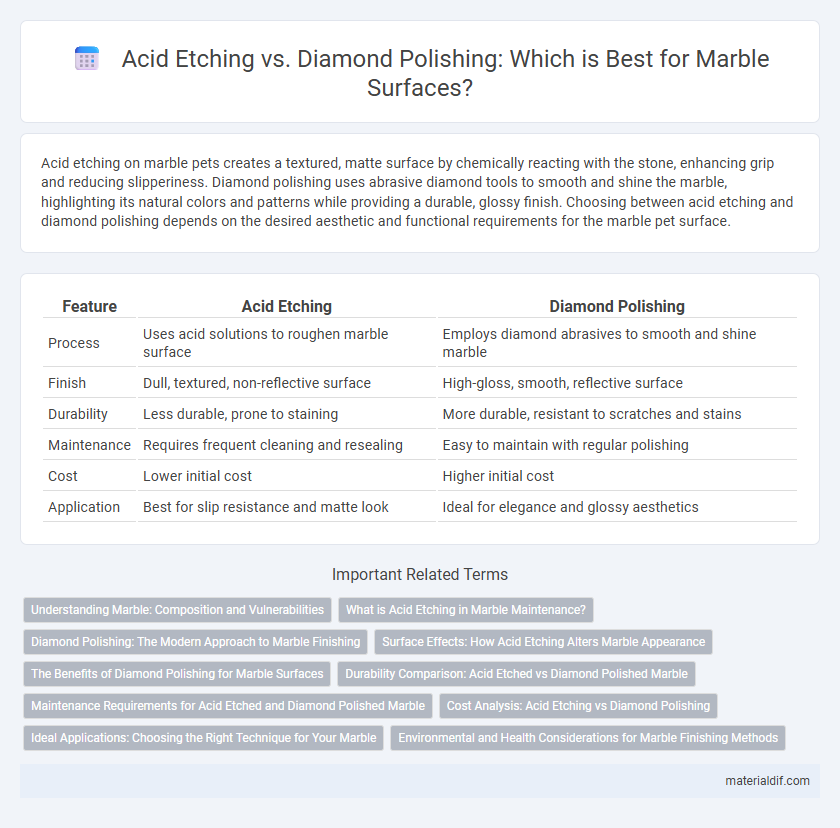Acid etching on marble pets creates a textured, matte surface by chemically reacting with the stone, enhancing grip and reducing slipperiness. Diamond polishing uses abrasive diamond tools to smooth and shine the marble, highlighting its natural colors and patterns while providing a durable, glossy finish. Choosing between acid etching and diamond polishing depends on the desired aesthetic and functional requirements for the marble pet surface.
Table of Comparison
| Feature | Acid Etching | Diamond Polishing |
|---|---|---|
| Process | Uses acid solutions to roughen marble surface | Employs diamond abrasives to smooth and shine marble |
| Finish | Dull, textured, non-reflective surface | High-gloss, smooth, reflective surface |
| Durability | Less durable, prone to staining | More durable, resistant to scratches and stains |
| Maintenance | Requires frequent cleaning and resealing | Easy to maintain with regular polishing |
| Cost | Lower initial cost | Higher initial cost |
| Application | Best for slip resistance and matte look | Ideal for elegance and glossy aesthetics |
Understanding Marble: Composition and Vulnerabilities
Marble is primarily composed of calcium carbonate, making it susceptible to acids and abrasion. Acid etching chemically reacts with the marble surface, causing dull spots and surface degradation, while diamond polishing mechanically smooths and restores the marble's shine without altering its chemical structure. Understanding marble's vulnerability to acidic substances informs the choice between acid-sensitive treatments and durable polishing methods for maintenance and restoration.
What is Acid Etching in Marble Maintenance?
Acid etching in marble maintenance refers to a chemical process that uses acidic solutions to create a textured, matte finish by dissolving the stone's surface layer. This technique is often employed to remove minor stains, surface imperfections, or to achieve a decorative, aged appearance. Unlike diamond polishing, which restores marble's natural shine through abrasive grinding, acid etching alters the stone's surface chemically, requiring careful application to avoid damage.
Diamond Polishing: The Modern Approach to Marble Finishing
Diamond polishing enhances marble surfaces by using diamond abrasives to create a smooth, high-gloss finish that brings out the stone's natural patterns and colors. This modern technique improves durability and resistance to scratching and staining compared to traditional acid etching, ensuring long-lasting beauty and easier maintenance. Marble treated with diamond polishing maintains its elegance over time, making it a preferred choice for both residential and commercial applications.
Surface Effects: How Acid Etching Alters Marble Appearance
Acid etching creates a textured, matte surface on marble by chemically reacting with its calcium carbonate, resulting in a duller and rougher appearance that highlights natural veins and imperfections. This process contrasts with diamond polishing, which smooths and enhances the marble's shine by mechanically grinding and buffing the surface to a high gloss. The altered surface from acid etching is more porous and susceptible to staining, affecting both aesthetics and maintenance compared to the protective, reflective finish achieved through diamond polishing.
The Benefits of Diamond Polishing for Marble Surfaces
Diamond polishing enhances marble surfaces by creating a high-gloss finish that intensifies the stone's natural color and veining, providing superior aesthetic appeal. This method offers increased durability and resistance to scratches and stains compared to acid etching, making marble surfaces easier to maintain over time. The non-invasive nature of diamond polishing preserves the integrity of marble while delivering a smooth, refined texture that significantly extends the surface's lifespan.
Durability Comparison: Acid Etched vs Diamond Polished Marble
Diamond polishing enhances marble's surface hardness and resistance to scratches, providing long-lasting durability suitable for high-traffic areas. Acid etching, while effective for creating a textured, matte finish, compromises the stone's integrity by introducing micro-abrasions that reduce its resistance to staining and wear. Consequently, diamond polished marble maintains structural strength and aesthetic appeal far longer than acid etched marble under daily use conditions.
Maintenance Requirements for Acid Etched and Diamond Polished Marble
Acid etched marble requires frequent resealing and careful cleaning to protect its porous surface from stains and etching, making maintenance more intensive compared to diamond polished marble. Diamond polished marble boasts a dense, glossy finish that resists stains and scratches, allowing for easier routine cleaning and less frequent resealing. Homeowners and facility managers often prefer diamond polished marble for high-traffic areas due to its durability and lower upkeep demands.
Cost Analysis: Acid Etching vs Diamond Polishing
Acid etching on marble surfaces generally incurs lower upfront costs compared to diamond polishing, making it a budget-friendly option for achieving matte finishes. Diamond polishing, however, demands higher investment due to specialized equipment and skilled labor but provides superior durability and a high-gloss finish that can increase property value. Long-term maintenance expenses for acid-etched marble tend to be higher, as the finish is less resistant to stains and wear compared to the more resilient and easily cleaned polished surface.
Ideal Applications: Choosing the Right Technique for Your Marble
Acid etching is ideal for creating a honed finish on marble surfaces, enhancing slip resistance in high-traffic areas like bathrooms and kitchens. Diamond polishing produces a high-gloss, reflective surface best suited for luxury spaces such as hotel lobbies and upscale residential flooring. Selecting between acid etching and diamond polishing depends on the desired aesthetic and functional requirements, balancing durability with maintenance needs.
Environmental and Health Considerations for Marble Finishing Methods
Acid etching on marble surfaces involves the use of strong acids that release harmful fumes, posing respiratory risks to workers and causing environmental pollution through chemical runoff. Diamond polishing is a mechanical process that avoids toxic chemicals, significantly reducing health hazards and minimizing environmental impact by producing only inert dust particles. Choosing diamond polishing promotes safer working conditions and aligns with sustainable marble finishing practices by eliminating acid-based waste.
Acid Etching vs Diamond Polishing Infographic

 materialdif.com
materialdif.com